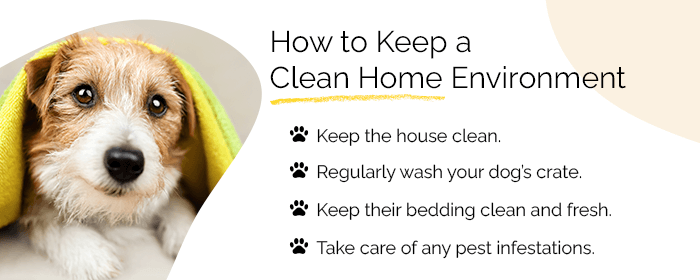
Dog nail infections are pretty common. This is why dog nail care is so important — it can help to keep paws clean and free from harmful germs and bacteria. Yet even with great paw grooming, infected dog nails still happen. All nails are susceptible to infections, including the dewclaw at the side of the foot. They must be treated promptly before the bacteria or fungi spread and multiply.
Here we look at the different types of dog nail infections, common symptoms to look out for, and treatment options. We also share preventative tips so your dog doesn’t have to suffer ever again.
Dog Nail Infection Symptoms
You might be wondering what an infected dog nail looks like. Thankfully, there are many symptoms to look out for that make it apparent something is wrong. If you spot any of the below signs, consider calling your vet and scheduling an appointment:- Excessive licking or chewing of the paw
- Discolored or bleeding nails
- Nails that are brittle, broken, or soft
- Smelly paws due to bacterial or fungal growth
- Dog toe that is swollen around the nail due to inflammation
- Limping due to pain in the foot
- Pus coming from the infected nail bed
Types of Dog Nail Infections
There are two main types of dog nail infections: bacterial infections and fungal infections. Both can cause an infected dewclaw or infect any other of your dog’s nails. In the below sections, we share the causes, potential risks, and treatment options for both.
Bacterial Dog Nail Infection
Bacterial dog nail infections usually happen when there is a small wound near the nail bed. Harmful bacteria can easily contaminate this small cut and cause an infection. Dogs can also get bacterial infections from chewing on their nails. Their mouths are full of bacteria, which are transferred into the open wound through licking and chewing.
No matter what the cause, it is vital to get a bacterial dog nail bed infection treated promptly. If it is left to worsen, the infection can spread to other areas of the body. This can lead to health complications such as bone infections or osteomyelitis. Keep an eye out for signs of swollen paws, discolored nails, and other symptoms listed above, and call your vet if you think the nail is infected.
Your vet needs to take a sample from your dog’s infected nail to see what bacteria is present. Most bacterial infections require antibiotic treatment. Mild infections can usually be treated with a topical antibiotic treatment combined with paw soaks. However, if the infection has progressed beyond the nail and the nail bed, a 4-6 week course of oral antibiotics is generally required.
Fungal Dog Nail Infection
Fungal infections are not common in dogs and usually infect cats. However, several types of nail fungus can infect dogs, including Leishmania, Blastomyces dermatitis, Microsporum canis, Microsporum gypseum, and Trichophyton mentagrophytes. These are usually picked up by treading on fungus that lives in the soil or moldy areas. If your dog’s paws are wet, these fungi will thrive and can cause pretty severe and painful infections.
Dog nail fungal infections also need to be treated quickly and must be inspected by a vet. Like bacterial infections, your vet may recommend paw soaks, oral antifungal medication, or topical antifungal creams. Treatment length depends on the severity of the infection. However, most will clear up within 3-4 weeks. Your dog’s diet plays an important role in recovery, and they need the right nutrients to strengthen their immune system.

Common Causes of Nail Infections
While fungus and bacteria are prevalent reasons why dogs experience nail infections, a handful of other reasons could be causing them. Weakened immune systems, tumors, neoplasia, and congenital disorders are on the rarer side of potential causes. Some of the more popular explanations for your pup's nail infection include:
Ingrown Nails
Whether your pup doesn't like getting their nails clipped or you have an elderly dog dealing with accelerated nail growth, ingrown nails might become an issue. If their nails get too long, they can curl into the bottom of their paws, break the skin, and fester into an infection. Unfortunately, this could lead to extreme pain and even immobility.
Nail Trauma or Injury
One of the most common causes of dog nail infections is prior trauma or injury. On walks and during games of fetch, your four-legged friend can step on glass or sharp rocks, burn their paws on hot asphalt, or break, crack, and split their nails on other foreign objects. This trauma can cause open wounds, lesions, and infections around their nails, often made worse by licking and chewing.
Allergies
Like many humans, dogs deal with allergies regularly. Food and environmental allergies are pretty common in countless dog breeds. Some of the most prevalent dog allergies include:
- Pollen
- Molds
- Fleas
- Wheat
- Soy
- Dairy
- Trees
- Grass
If your dog has any of these allergies, they can experience red, inflamed, and itchy skin around their paws and nails. Allergies may also cause extremely uncomfortable yeast infections, discolor your pup's paws, or induce intense licking and scratching.
Lupoid Onychodystrophy
If your pup is experiencing repetitive issues with its paws and claws, it may be dealing with lupoid onychodystrophy. This autoimmune nail disorder can affect your dog's nails, causing them to become misshapen, turn brittle, thicken, or even fall out. Subsequently, your dog will experience significant pain, extreme swelling, and bleeding. Unfortunately, there isn't a cure for lupoid onychodystrophy, but treatment can manage infected dog nail symptoms and other side effects.
Infected Dog Nail Prevention
Knowing how to cure an infected toe on a dog is a must for pet parents. In almost all cases, it is advisable to get advice from a vet and use an antibiotic or antifungal treatment they recommend. However, once the infection has cleared, you should practice preventative methods. This will save you money and time at the vet and spare your canine companion the discomfort!
Here are some things you can do to help prevent dog nail infections in the future:
Clean Home Environment

- Keep the house clean.
- Regularly wash your dog’s crate.
- Keep their bedding clean and fresh.
- Take care of any pest infestations.
Avoid Dirty Areas on Walks
Bacteria and fungi are lurking everywhere! However, they are found in much higher quantities on the beach, in wet soil, or in moldy areas. If you regularly take your dog on forest walks or to the beach, consider sticking to the path. Or, if you still want to let your dog explore freely, keep track of his movements and don’t let him explore any suspiciously dirty areas. This should help prevent dog nail infections in the future.Maintain Paw Grooming Routine
Establishing and sticking to a paw grooming routine can help prevent a dog nail bed infection. We recommend sticking to this three-step paw grooming process for the best results:- Clean the paws: Paw cleaning, especially after long walks in dirty areas, removes any dirt and bacteria from the paws. Get into the habit of doing this regularly, and you can remove any pathogens before they cause infection.
- Trim paw hair: It is important to trim paw hair and cut away any matted fur. Long hair or tangled clumps are the ideal breeding ground for bad bacteria. Removing these clumps makes it less likely they will infect the toenail.
- Trim dog nails: Nail trimming is also a must! Keep your dog's nails short, and you will avoid issues such as ingrown nails or nail injuries. Both of these can lead to infections, so keeping the nails trim and healthy is essential.
Implement a Healthy Diet
What your dog eats dramatically impacts the strength of its immune system. Dogs that receive all the essential nutrients through their diets are going to be better at fighting off infections. This means they might be able to fight off bacteria and fungi by themselves before it gets out of hand.
Likewise, a healthy diet strengthens the nails. This makes nail injuries and thus dog nail infections less likely. Therefore, you must implement a healthy diet packed with everything your dog needs.
Perform Regular Paw Checks
Finally, a great way to prevent dog nail fungus and bacterial infections is with regular paw checks. Every time you groom your furry friend, check their paws and nails for the symptoms listed above. If you spot any signs of inflammation or discomfort, schedule an appointment with your vet.
You should also consider regular prophylactic medical examinations with your vet to help identify and treat dog nail infections as quickly as possible. The sooner the infection is picked up, the easier and quicker it is to treat.
Final Thoughts
Unhealthy dog nails are pretty common. After all, dogs spend most of their waking hours on their paws! They are in constant contact with surfaces that can harbor germs and pathogens, so it doesn’t take long for infections to occur.
If you spot any signs or dog nail bed infections, book a veterinary appointment immediately so you can begin treatment. Don’t forget the benefits of good paw care either! Paw care can go a long way in speeding up the recovery process and preventing future bacterial and fungal nail infections.
Last Updated on July 26, 2023 at 8:30 AM

